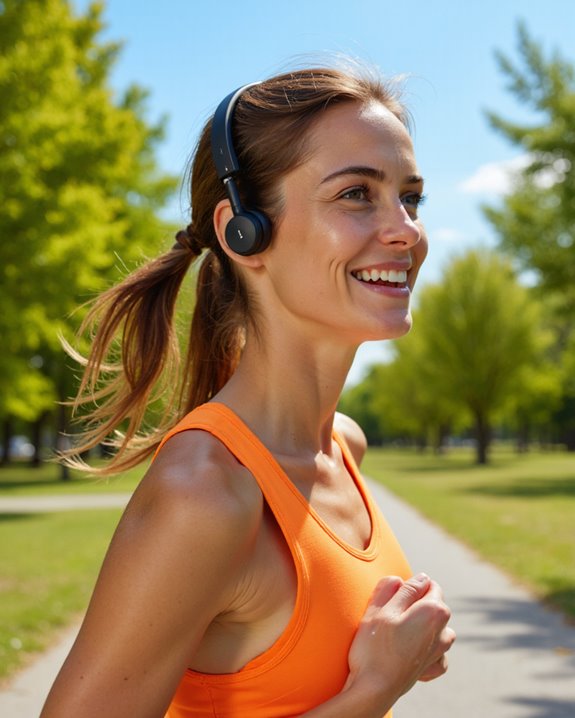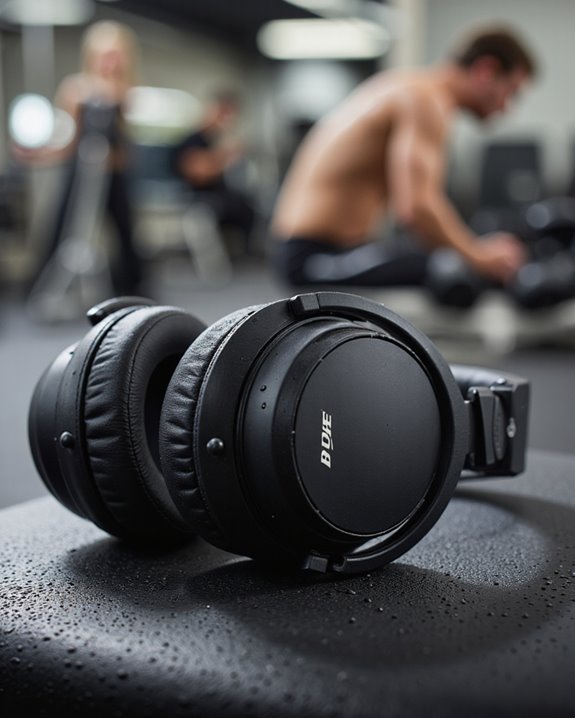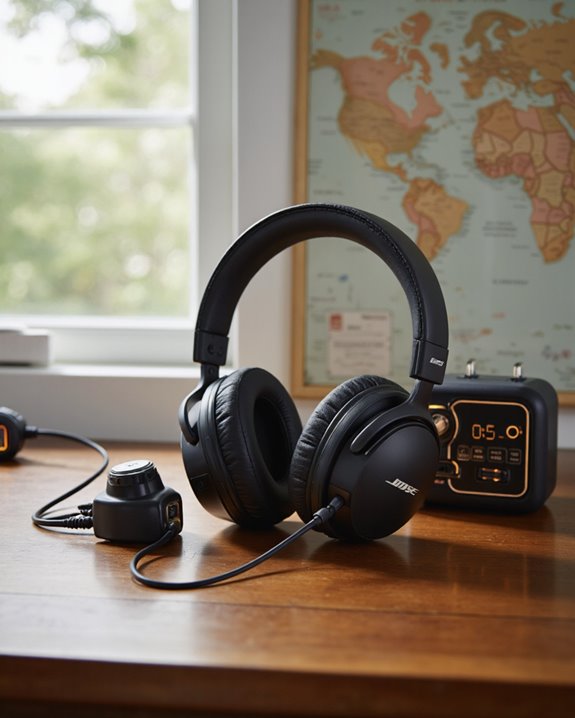As an Amazon Associate, we earn from qualifying purchases. Some links may be affiliate links at no extra cost to you. Although our opinions are based on curated research, we haven't used these products. Articles generated with AI.
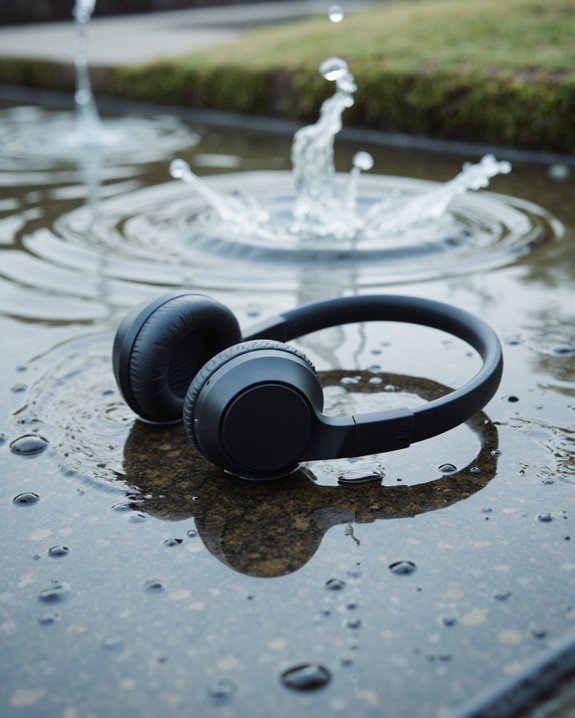
Are Bone Conduction Headphones Waterproof?
Bone conduction headphones do come in waterproof models, like the Shokz OpenSwim (IP68) and Gliolmeits DG08-PRO (IPX7), making them suitable for swimming and workouts in wet conditions. These ratings mean they can handle full submersion—IPX7 withstands 1 meter for 30 minutes, while IPX8 handles greater depths and time. Since Bluetooth doesn’t transmit well underwater, most rely on built-in MP3 players for music. If you’re comparing features or seeking top picks, more details follow.
Key Takeaways
- Many bone conduction headphones are designed with waterproof ratings, such as IPX7 or IPX8, for use in wet environments.
- IPX7-rated models can withstand immersion in 1 meter of water for up to 30 minutes.
- IPX8-rated bone conduction headphones are suitable for continuous underwater use, such as swimming laps.
- Waterproof bone conduction headphones often feature onboard MP3 storage since Bluetooth signals do not transmit well underwater.
- These headphones maintain comfort and hygiene by leaving ears open and fitting securely under swim caps.
Understanding Bone Conduction Headphone Technology
Bone conduction technology offers a distinct approach to audio delivery, diverging from the traditional reliance on air conduction through the ear canal. With open-ear bone conduction technology, these headphones transmit sound vibrations directly through our cheekbones, bypassing the eardrum entirely. This design not only leaves our ears open for greater comfort and less fatigue but also preserves situational awareness, which is critical for outdoor athletes or swimmers. Many models are engineered to be fully waterproof, extending their utility into aquatic environments. While the sound quality is great for most everyday uses, we may notice a reduction in bass response underwater compared to conventional headphones. Still, the ability to enjoy music while swimming or running—even in challenging conditions—makes these waterproof devices a compelling audio solution. Most top swimming headphones feature IPX8 or IP68 waterproof ratings, allowing submersion up to 3 meters deep for reliable underwater use.
Waterproof Ratings and What They Mean
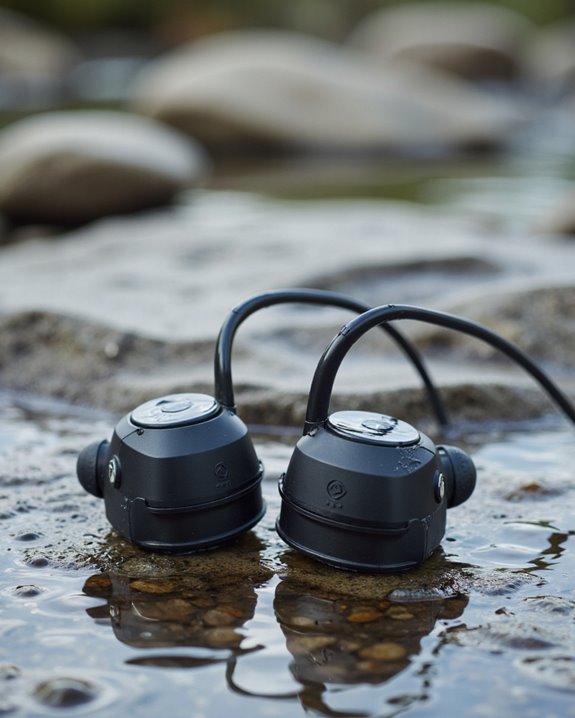
When evaluating waterproof bone conduction headphones, understanding IP (Ingress Protection) ratings is essential for making informed choices, especially if we plan to use them in wet environments. Waterproof ratings like IPX7 and IPX8 specify exactly how much water exposure our headphones can withstand. An IPX7 rating means the device can survive immersion in up to 1 meter of water for 30 minutes, making it suitable for rain or accidental splashes. For swimming or extended underwater use, we should look for an IPX8 rating, which indicates the headphones can endure continuous immersion at depths beyond 1 meter. Many bone conduction headphones, such as the Shokz OpenSwim, are engineered with these waterproof capabilities. Always refer to the IP rating to guarantee our headphones meet our activity requirements. Models like the Gliolmeits DG08-PRO even offer IPX7 waterproofing, ensuring protection against sweat and rain during workouts.
How Bone Conduction Headphones Perform in Water
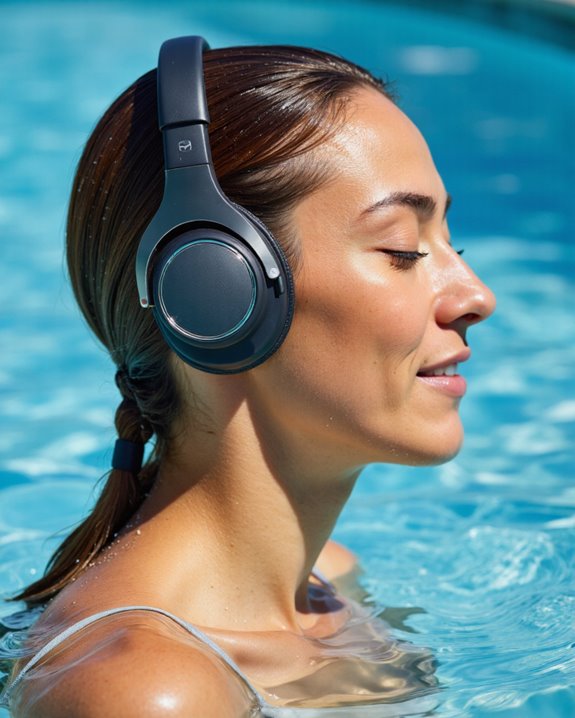
With a clear understanding of waterproof ratings, we can now examine how bone conduction headphones actually function during aquatic activities.
Waterproof bone conduction headphones, particularly those with an IPX8 rating, are engineered for complete submersion—ideal for lap swimming and water sports. By transmitting sound through our cheekbones rather than blocking our ears, these headphones let us stay aware of our surroundings even underwater. Many models, such as those with a built-in MP3 player, eliminate the need for a phone, enabling uninterrupted music playback as we swim. When worn under a swim cap, the headphones’ secure fit resists shifting during intense movement. Battery life typically reaches up to 8 hours, though underwater usage averages about 4 hours, providing sufficient duration for most training sessions or recreational swims without interruption.
Onboard Music Storage vs. Bluetooth Underwater
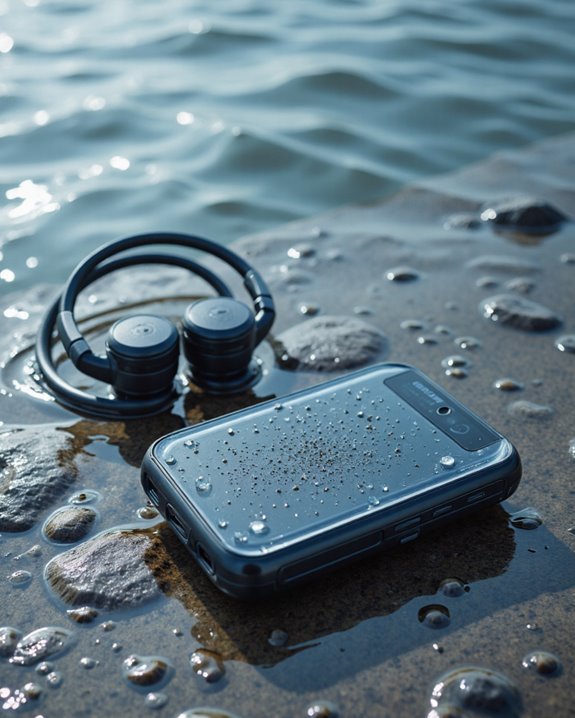
Although Bluetooth headphones dominate the market for wireless audio on land, their limitations become immediately apparent underwater—radio signals like Bluetooth simply can’t penetrate water effectively. For waterproof bone conduction swimming headphones, this means we need to rethink how we access our music while submerged. Onboard music storage becomes essential; models like the AfterShokz Xtrainerz offer 4GB or 32GB of internal memory, supporting audio formats such as MP3, WAV, WMA, AAC, and FLAC. This lets us transfer playlists directly to our headphones, bypassing the need for a Bluetooth Connection altogether. With up to 8 hours of battery life (4 hours underwater), we can enjoy uninterrupted audio throughout swim sessions. For swimmers and athletes, onboard storage guarantees compatibility and reliability—features Bluetooth alone can’t deliver underwater. Devices like the OpenSwim provide IP68 waterproof protection, ensuring durability and performance in water environments.
Fit, Comfort, and Security During Aquatic Activities
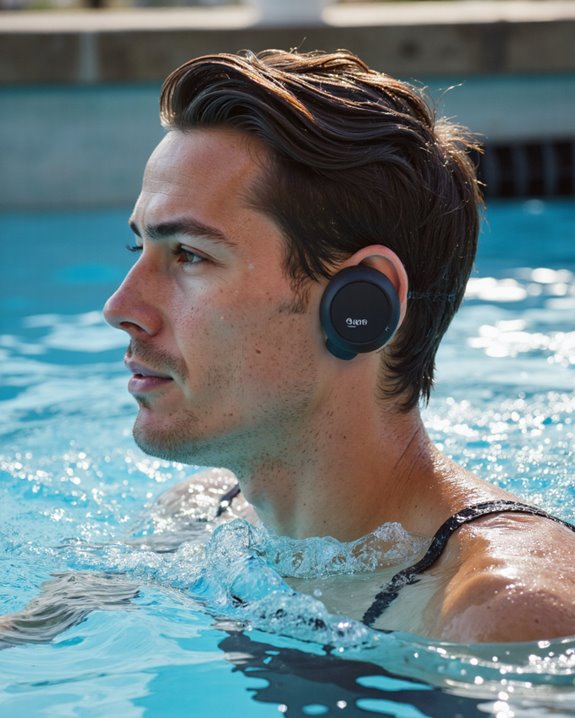
Accessing music underwater is only half the equation; guaranteeing our headphones stay secure, comfortable, and unobtrusive during aquatic workouts is just as important. With bone conduction headphones like the AfterShokz Xtrainerz, we benefit from a waterproof design tailored for swimming. Their ergonomic fit guarantees security even through vigorous strokes, tumble-turns, or extended pool sessions. Unlike traditional in-ear models, the lightweight frames of bone conduction headphones minimize fatigue, making long swim workouts more comfortable. The compatibility with swim caps and goggle straps further enhances fit and stability, preventing unwanted movement or slippage. This secure, open-ear approach allows us to focus on performance, not on constantly adjusting our gear. Ultimately, bone conduction technology delivers an effective blend of waterproof reliability, comfort, and security for aquatic activities.
Benefits of Open-Ear and Hygienic Design

Thanks to their open-ear construction, bone conduction headphones introduce a significant advantage for swimmers and water sports enthusiasts seeking both performance and hygiene. This open ear design keeps our ear canals completely unobstructed, minimizing the risk of ear infections such as swimmer’s ear. Unlike traditional earbuds that trap moisture and bacteria, bone conduction headphones rest gently on our cheekbones, offering a hygienic design ideal for aquatic environments. With an IPX8 waterproof rating, these devices withstand full immersion, ensuring reliability during swimming or vigorous water activities. The lightweight, ergonomic build further enhances comfort, reducing ear fatigue over extended sessions. Additionally, maintaining awareness of our surroundings is essential in aquatic settings—open ear technology lets us stay alert and safe without sacrificing audio quality or personal hygiene.
Top Picks for Waterproof Bone Conduction Headphones
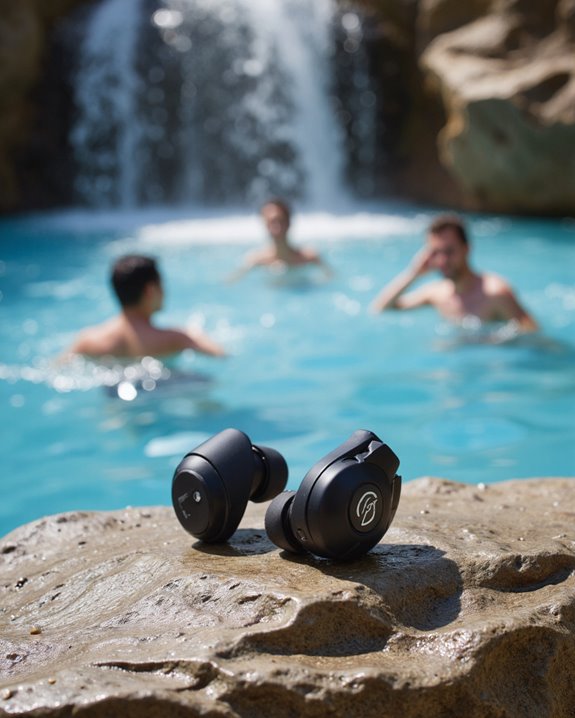
When evaluating the best waterproof bone conduction headphones, we should consider not only their technical specifications but also how each model aligns with specific aquatic activities and user preferences. The Shokz OpenSwim Pro stands out with an IPX8 waterproof rating, Bluetooth connectivity, and 32GB onboard music storage—ideal for swimming and water sports. The H2O Audio Tri Multi-Sport offers 8GB storage and bass-heavy sound, excelling in both swimming and outdoor environments, though Bluetooth is limited underwater. For those wanting streaming music while submerged, the Zygo Solo employs an FM transmitter and provides a secure fit. Nank Runner Diver2 Pro leads with 36GB storage and Bluetooth support above water. Meanwhile, the Shokz OpenSwim guarantees stability with swim caps and delivers 10-hour battery life and 4GB MP3 storage.
Frequently Asked Questions
Can You Swim in Bone Conduction Headphones?
We can swim in bone conduction headphones designed for swimming safety, like the Shokz OpenSwim, thanks to their high waterproof ratings. In our experience, their sound quality holds up well, and these models come highly recommended by users.
Can You Use Bone Conduction Headphones in the Shower?
We can use bone conduction headphones in the shower if they have adequate water resistance for shower safety. For the best sound quality, let’s follow usage tips and maintenance advice, like drying them thoroughly after each use.
What Is the Downside of Bone Conduction Headphones?
When we consider bone conduction headphones, we notice downsides like limited sound quality, variable comfort level during long use, and shorter battery life. Market options can lack features, and some usage scenarios might not suit these headphones well.
Can You Wear Aftershokz in the Pool?
We can definitely wear AfterShokz in the pool—they’re waterproof headphones with impressive durability. Bone conduction technology keeps our ears open for swimming safety, and while sound quality differs from regular headphones, it’s perfect for underwater listening.

